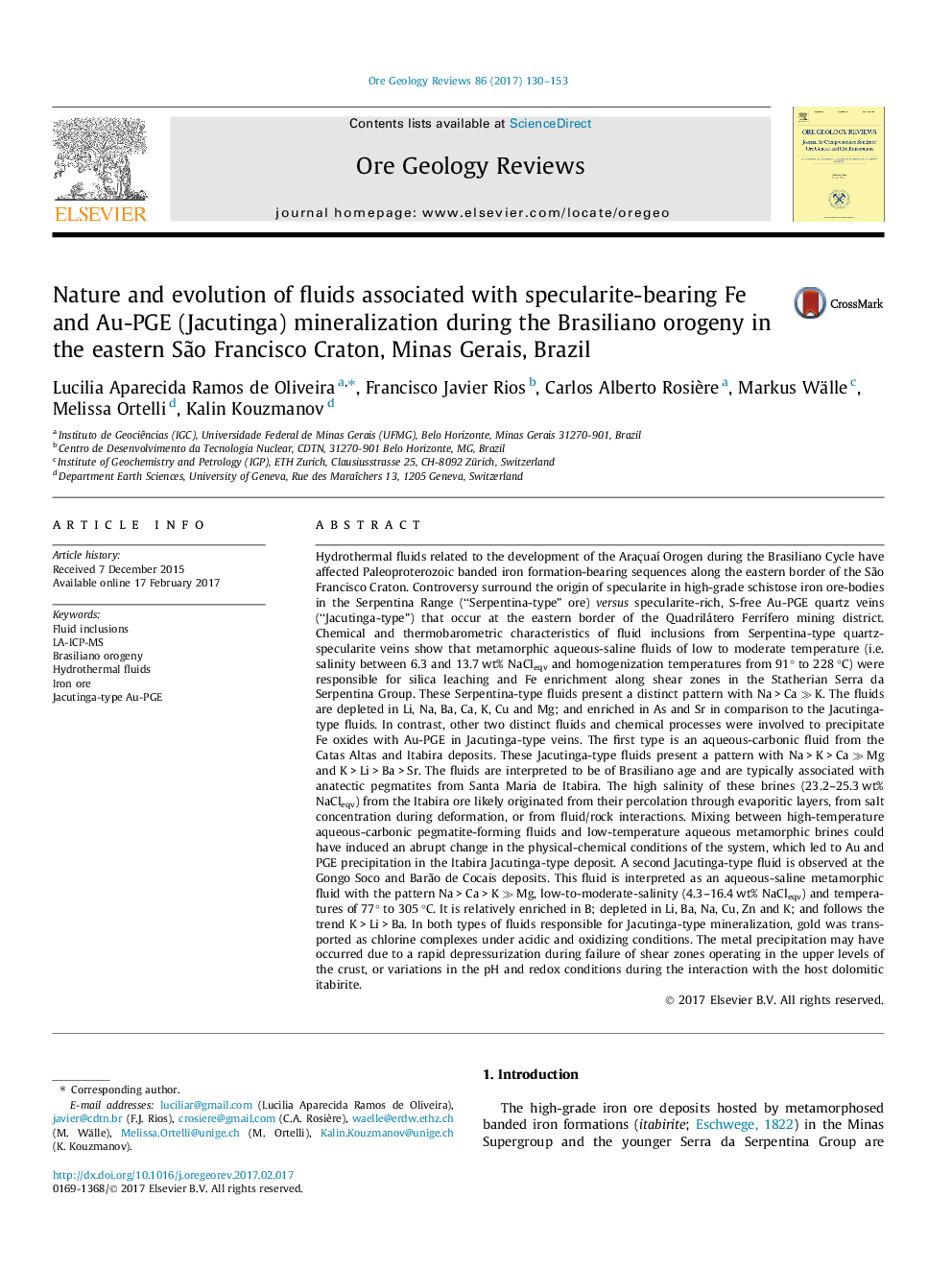| کد مقاله | کد نشریه | سال انتشار | مقاله انگلیسی | نسخه تمام متن |
|---|---|---|---|---|
| 5782397 | 1637221 | 2017 | 24 صفحه PDF | دانلود رایگان |

- Hydrothermal metamorphic fluids generated iron ore bodies and Jacutinga-type veins.
- Low-temperature aqueous-saline fluid is responsible for Fe-enrichment.
- Mixing of aqueous-carbonic fluid with high-saline brine lead to Au precipitation.
- Metamorphic low temperature fluid is responsible for Au-PGE mineralization.
Hydrothermal fluids related to the development of the Araçuaà Orogen during the Brasiliano Cycle have affected Paleoproterozoic banded iron formation-bearing sequences along the eastern border of the São Francisco Craton. Controversy surround the origin of specularite in high-grade schistose iron ore-bodies in the Serpentina Range (“Serpentina-type” ore) versus specularite-rich, S-free Au-PGE quartz veins (“Jacutinga-type”) that occur at the eastern border of the Quadrilátero FerrÃfero mining district. Chemical and thermobarometric characteristics of fluid inclusions from Serpentina-type quartz-specularite veins show that metamorphic aqueous-saline fluids of low to moderate temperature (i.e. salinity between 6.3 and 13.7 wt% NaCleqv and homogenization temperatures from 91° to 228 °C) were responsible for silica leaching and Fe enrichment along shear zones in the Statherian Serra da Serpentina Group. These Serpentina-type fluids present a distinct pattern with Na > Ca â«Â K. The fluids are depleted in Li, Na, Ba, Ca, K, Cu and Mg; and enriched in As and Sr in comparison to the Jacutinga-type fluids. In contrast, other two distinct fluids and chemical processes were involved to precipitate Fe oxides with Au-PGE in Jacutinga-type veins. The first type is an aqueous-carbonic fluid from the Catas Altas and Itabira deposits. These Jacutinga-type fluids present a pattern with Na > K > Ca â«Â Mg and K > Li > Ba > Sr. The fluids are interpreted to be of Brasiliano age and are typically associated with anatectic pegmatites from Santa Maria de Itabira. The high salinity of these brines (23.2-25.3 wt% NaCleqv) from the Itabira ore likely originated from their percolation through evaporitic layers, from salt concentration during deformation, or from fluid/rock interactions. Mixing between high-temperature aqueous-carbonic pegmatite-forming fluids and low-temperature aqueous metamorphic brines could have induced an abrupt change in the physical-chemical conditions of the system, which led to Au and PGE precipitation in the Itabira Jacutinga-type deposit. A second Jacutinga-type fluid is observed at the Gongo Soco and Barão de Cocais deposits. This fluid is interpreted as an aqueous-saline metamorphic fluid with the pattern Na > Ca > K â«Â Mg, low-to-moderate-salinity (4.3-16.4 wt% NaCleqv) and temperatures of 77° to 305 °C. It is relatively enriched in B; depleted in Li, Ba, Na, Cu, Zn and K; and follows the trend K > Li > Ba. In both types of fluids responsible for Jacutinga-type mineralization, gold was transported as chlorine complexes under acidic and oxidizing conditions. The metal precipitation may have occurred due to a rapid depressurization during failure of shear zones operating in the upper levels of the crust, or variations in the pH and redox conditions during the interaction with the host dolomitic itabirite.
Journal: Ore Geology Reviews - Volume 86, June 2017, Pages 130-153